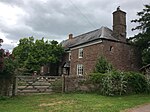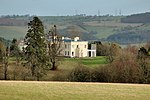Lower Dyffryn House, Grosmont
Buildings and structures in MonmouthshireCountry houses in WalesGrade II* listed buildings in MonmouthshireRegistered historic parks and gardens in Monmouthshire

Lower Dyffryn House, Grosmont, Monmouthshire is a farmhouse dating from the 16th century. Owned by a Sheriff of Monmouthshire in the early 1600s, it was rebuilt by the Cecil family in the mid 17th century as a substantial mansion to the typical Elizabethan e-plan. Its fortunes declined in the 19th century by which point it had been reduced to a farmhouse and much of its external and internal fittings were removed or replaced. The farmhouse is Grade II* listed and a number of the ancillary buildings have their own Grade II listings. The gardens, which are contemporaneous with the house, are included on the Cadw/ICOMOS Register of Parks and Gardens of Special Historic Interest in Wales.
Excerpt from the Wikipedia article Lower Dyffryn House, Grosmont (License: CC BY-SA 3.0, Authors, Images).Lower Dyffryn House, Grosmont
Geographical coordinates (GPS) Address Nearby Places Show on map
Geographical coordinates (GPS)
| Latitude | Longitude |
|---|---|
| N 51.9002 ° | E -2.8223 ° |
Address
Grosmont
, Grosmont
Wales, United Kingdom
Open on Google Maps










